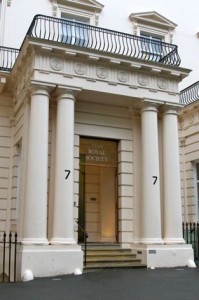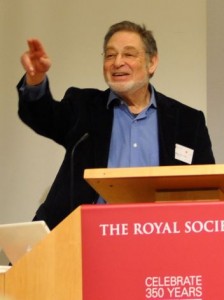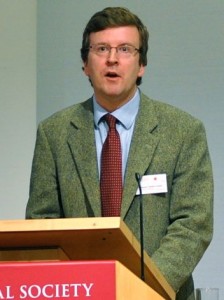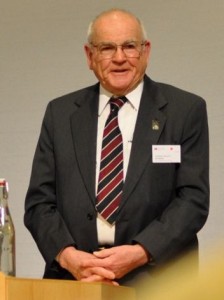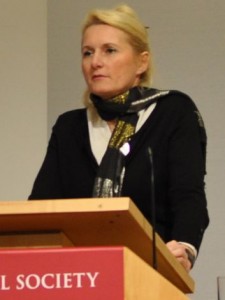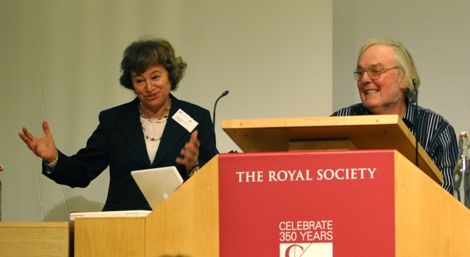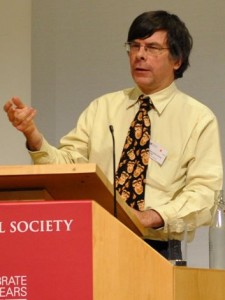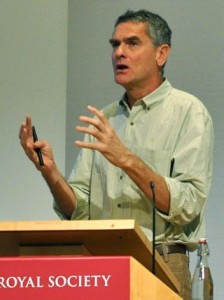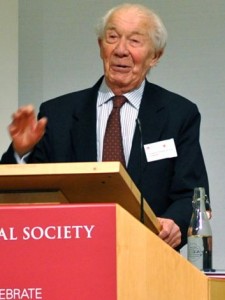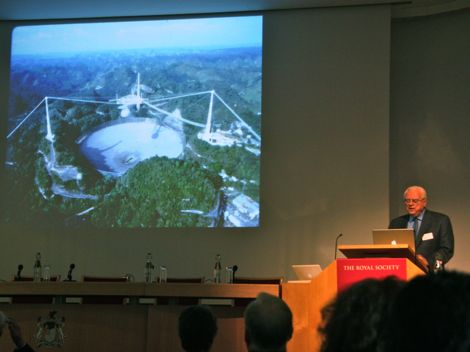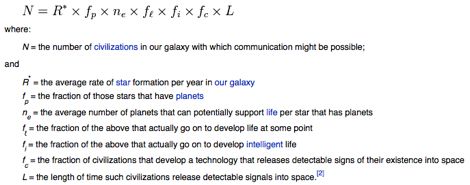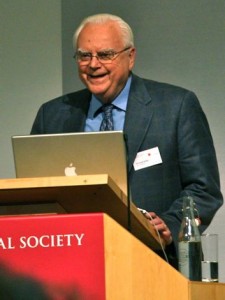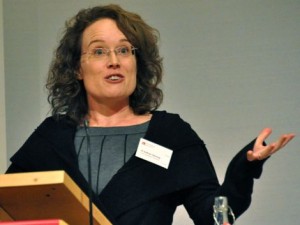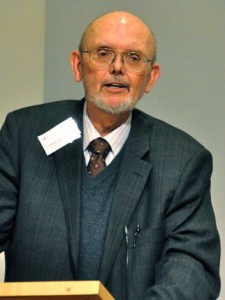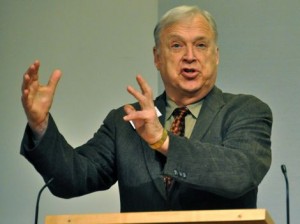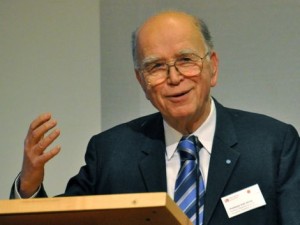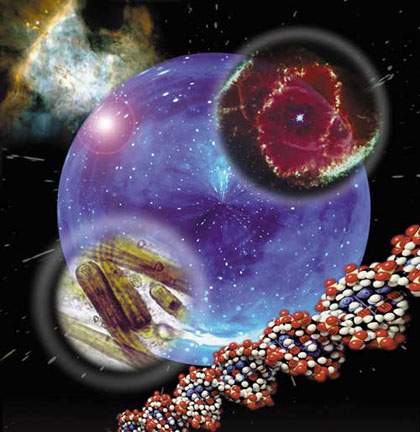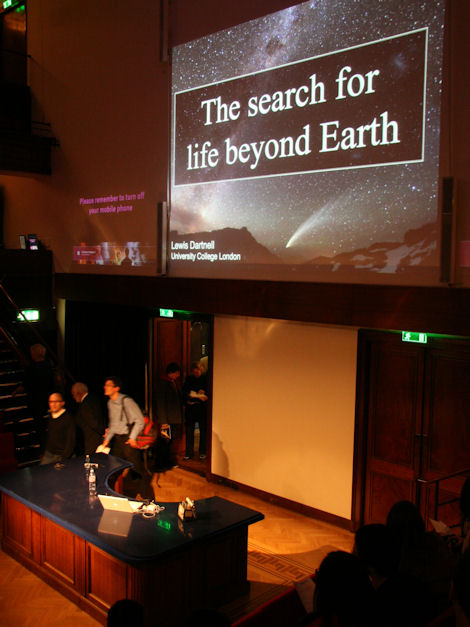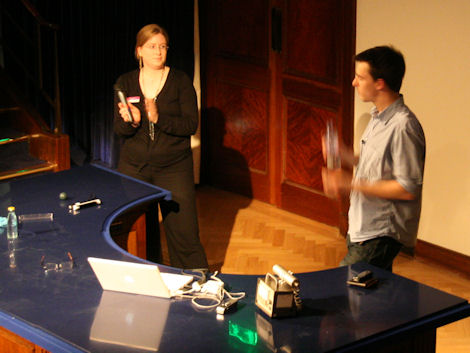“Ladies and gentlemen, I have a grave announcement to make. Incredible as it may seem, both the observations of science and the evidence of our eyes lead to the inescapable assumption that those strange beings who landed in the Jersey farmlands tonight are the vanguard of an invading army from the planet Mars.”
Those words were spoken by a fictitious news reporter in Orsen Welles’s 1938 radio play ‘The War of the Worlds’ – a broadcast that probably did more than any other event in the 20th century to embed the prospect of extra-terrestrial life in the popular imagination.
I was inspired to replay this old favourite after joining last week’s Royal Society discussion meeting on ‘The detection of extra-terrestrial life and the consequences for science and society‘.
Listeners to Welles’s play are said to have run screaming into the streets, taking the Martian invasion for real. Yet that reaction, said Professor Albert Harrison from the University of California, Davis, has been overplayed and, in fact, many listeners followed much more rational courses of action. Harrison’s comments are consistent with the Royal Society’s intent that this meeting explore beyond the bounds of natural science – to consider the social, cultural, and political impacts of the search and possible discovery of extra-terrestrial life.
It’s tricky to focus down 16 speakers and 14 hours of discussions, but for me everything feeds into three questions:
-
Is there life beyond the earth?
-
Is there intelligent life beyond the earth?
-
How might human beings react to the discovery of extra-terrestrial life?
(o.k., there’s also a significant ‘sub-plot’ around the possibility that life evolved on earth in several independent forms – more of which later.)
Echoing an early speaker, I’ll say up front that there is presently no evidence for the existence of extra-terrestrial life, intelligent or otherwise. But that doesn’t mean it isn’t out there. Sorry if that ruined the sense of chair-gripping suspense I’ve been building.
Is there life beyond the earth?
Where life?
Strangely perhaps, the search for ET begins on Earth, in so far as understanding how terrestrial life came to exist and evolve tells us what to expect elsewhere.
But beyond the Earth, researchers are looking in two places :
(a) planets in our own solar system
(b) planets in orbit around other stars in our galaxy
Why life?
With evidence that physics and chemistry are uniform across the universe, the argument is that if we find life in one location, then why not in another. It’s quite convincing if said quickly.
But conscious human life appears only at the end of a road full of hurdles, and we really need to understand how challenging each stage of the process is before raising expectations of a repeat performance. When Pascale Ehrenfreund described the ubiquity of carbonaceous compounds in the universe, she did so against a history starting at the big bang, moving through the formation of chemical compounds, then on to DNA, and finally to life. The sequence goes something like:
1. The universe came into existence at the Big Bang (including time and space, energy and matter)
2. Matter condensed into galaxies of gas and stars, and elements and chemicals were produced
3. Chemicals became arranged so they were able to self-replicate and behave as ‘life’ (RNA>DNA>cell formation, or alternative chemical arrangements that fulfill the same function)
4. Simple life evolved into more complex forms through Darwinian natural selection
5. Complex life forms evolved intelligence
6. Intelligent life forms became self-aware (consciousness)
My critique of these is that (2) and (4) are uncontroversial: we directly observe elements and chemicals, including organic molecules in deep space; and stage (4) is simply the fact of Darwinian evolution. (5) – intelligence – could be considered an extension of evolution; but, for me, (6) – consciousness – is a separate deal. That’s not because I think consciousness requires supernatural intervention to make it happen, but more to highlight how little understood is the process by which matter gets to understand and act upon itself. If we’re so smart, where’s the AI – right?
Jumping back to (1) – the big bang – as the mechanism for the formation of our universe in isolation, that too is uncontroversial for many scientists. Yet, speculative concepts like the multiverse have bearing on discussions about the probability of life forming. This meeting avoided getting too far side-tracked into cosmological fundamentals and the more adventurous areas of scientific speculation. Indeed, I thought Paul Davies, author of the The Mind of God and The Goldilocks Enigma – works that major in this territory – showed great restraint.
On what life actually is, I found it hard to pin down a universally shared definition, but most include the ability to self-replicate and to behave autonomously. Other qualifying features might include complexity, the ability to grow and develop, and the presence of a nutrient-fed metabolism. I also liked Baruch Blumberg’s reference to a test that involves comparing the behaviour of live and dead chickens thrown into the air.
Astrobiology in a new Age of Wonder
For Blumberg, astrobiology and the search for ET represents a new Age of Wonder – driven by the Joseph Banks spirit found in Richard Holmes’s book of the same name, but enhanced through startling advances in technology. Astrobiologists are asking themselves if the commonality of biologies discovered across the globe in Banks’s time will now be reproduced at the universal scale.
The planets in our own solar system can be reached by physical probes, but so-called exoplanets orbiting distant stars (but still in our galaxy) must be detected and analysed remotely with instruments like the Kepler space telescope. This is an area where progress
has been extremely rapid and rewarding since the first Jupiter type gas giant planets were discovered 15 years ago. Researchers already analysing ‘super earths’ (x10 earth mass), said Michel Mayor, were on the brink of accessing planets equivalent in size and position to Earth. Still unresolvable as discs, exoplanets are detected from the way they change the apparent brightness and quality of light from the star-planet system. When a planet passes in front, it blocks out some light, and the reduction is measured by what is effectively a giant light-meter – like Kepler. Some new instruments in the pipeline, such as Plato scheduled for 2018, will open up more than half the sky for exoplanet analysis, further increasing the chances of discovering life.
But the little things can impress most, and one of the highlights for me was Malcolm Fridlund’s slide showing a very subtle dip in a star’s brightness curve, corresponding not to a reduction due to shadowing, but to the loss of reflected light from the planet itself as it passed behind the star. That somehow brought home the sensitivity of the technique.
Analysing the wavelength of light from these systems reveals chemicals in the exoplanet’s atmosphere that we can compare with chemicals that are associated with life in our own biosphere (or biofilm as Cockell would have it). For example, ozone, oxygen, methane, and water may indicate plant life. And as Pascale Ehrenfreund explained, the starting materials for carbon based life are common throughout the universe: including long carbon chains, fullerenes and PAHs (polycyclic aromatic hydrocarbons).
While there’s been a push to see earth sized planets – because we know they work I guess – larger planets are not ruled out, although it was suggested plate tectonics might limit development on larger rocky worlds. We know life can be surprisingly tough though, like the Earth-bound extremophile group chemolithotrophs, described by Charles Cockell, that can survive high temperatures, pressures, and strong saline solutions – extracting energy directly from rocks by oxidising iron.
So it was a little disappointing after all that to learn from Simon Conway Morris that conditions on Jupiter’s moon Europa may be too saline for life. Maybe I’ve watched the movie 2010 too often, but I had Europa pegged as a top contender (according to Chris McKay, Saturn’s largest moon Enceladus is now a more likely prospect).
But Morris’s main aim was to demonstrate the ubiquity of evolutionary convergence, with reference to basic life forms that had shown a tendency to independently converge on improved or even optimal designs through natural selection. This begs the question why, if life once started has little problem developing and converging across a range of environments, is the universe not teaming with life and its tell-tale transmissions (an example of the Fermi Paradox discussed later). Simon Conway Morris’s explanation is that basic life is indeed a (one off?) fluke.
Chris McKay’s ‘Second Genesis’ went some way to soften the prospect of life as a total fluke, his thesis being that we might find an independently developed tree of life in our own solar system. Just finding life or its artifacts in the rocks of, say, Mars won’t do though, as we know there’s been a historic transfer of rocks (below sterilisation temperatures) between the Earth and Mars caused by ejection of material by asteroid strikes.
Indeed – we may ourselves be Martians ! (A number of Martian meteorites have been found on earth, identified by analysing the composition of trapped gas bubbles and comparing it to samples analysed on Mars. A meteorite was found on Mars by Viking, but not from Earth – although such material is almost certainly there.)
Rather, life derived from a true second genesis would have to demonstrate features in its underlying structure, or building blocks, that must have arisen independently from our own tree of life, and will certainly not be part of it.
Is there intelligent life beyond the earth?
The second day’s discussions, chaired by Jocelyn Bell-Burnell and Martin Rees, focused on the search for intelligent extra-terrestrial life, or SETI, and how human beings might react to its discovery.
Maybe it’s a little unfair to suggest anyone working in this field is an inherent optimist, but I suspect such a condition is helpful.
At the start of this post, I listed the various stages or hurdles that must be jumped on the way to life. But for Christian de Duve, opening the session, the appearance of life on Earth is simply the inevitable outcome of a chemical process; such that if the same chemistry occurs elsewhere – the same sort of life will appear.
De Duve’s thesis of life as a cosmic imperative does rely on the same physical as well as chemical conditions being reproduced, but for me he didn’t adequately address the qualitative difference between the reaction of a homogenous mix of chemicals, and more complex processes such as the formation of self-reproducing entities like cells (via RNA and DNA). Assumptions around the inevitability of the switch from chemistry to ‘life chemistry’ are troubling. But maybe I just need to read De Duve’s book.
The Shadow Biosphere
Following Chris McKay’s discussion around a ‘Second Genesis’ in our solar system, Paul Davies followed similar motives with his concept of a more Earthbound ‘Shadow Biosphere’. Davies’s research, described in his forthcoming book, The Eerie Silence, may be terrestrial, but can inform the off-world search. The Shadow Biosphere, if it exists says Davies, will comprise unconventional (and unrecognised) life forms that have appeared and developed independently.
The lifeforms may have died out and be detectable only via ancient biomarkers, or they could be “under our noses” in the form of the largely overlooked extremophiles – those bugs that thrive variously in hot, high-pressure, salty and radiated environments. Davies described ongoing research at the hot pools of Mono Lake, California, where the search is on for arsensic-based micro-organisms, where arsenic may have replaced the phosphorous found in the tree of life we already know. Shadow organisms can thus look quite ordinary (whatever that means for an extremophile) but betray themselves by subtle but fundamental differences in their basic composition – such as inclusion of arsenic, or structure – such as the ‘handedness’ of their DNA. As with Second Genesis, the work has obvious implications for our view on the specialness of life-forming processes.
And while fishing around in hot pools might lack the superficial glamour of exoplanet and space research, the results could be of equal or greater significance. Also, with potential Martian finds arguably compromised by the possibility of inter-planetary material exchanges, the discovery of alternative trees of life on Earth might provide a more robust argument for the prevalence of life in the greater universe.
Is there anybody…..out there!
The attraction of SETI, officially celebrating its 50th anniversary this year, speaks for itself. Discovering the extra-terrestrial lettuce would be nice, but we’d all rather have the salad recipe beamed in from Vega.
Director of the Carl Sagan Center for the Study of Life in the Universe, Frank Drake, has been on the case from the start, and with Director of the Center for SETI Research, Jill Tarter, has been listening for radio, and more recently laser, broadcasts since the 1960s.
To help understand what he was up against odds-wise in the search, Drake proposed his now famous equation to calculate the number of civilisations in our galaxy with which communication might be possible:
Scaled up calculations suggest there are likely to be ten to the power 20 Earth-like planets in the observable universe, suggesting that if the road to intelligent life is ubiquitous and mechanical (which is not a given), the outlook for detection looks positive.
However, the Fermi Paradox, based on an observation by Enrico Fermi that we don’t see any evidence of life, because it either isn’t there or habitually destroys itself, runs counter to this enthusiasm. And as Paul Davies commented, the odds represented in the Drake equation terms (for and against life) stack up exponentially. Bottom line, I think these sorts of consideration should cause us to revisit any intuitive sense we might have for the inevitability of life – especially those of us from the Sagan “billions” generation.
Apart from radio waves and laser beams, aliens might give themselves away in other ways associated with their use of advanced technologies. One such technology is the Dyson Sphere. Proposed by Freeman Dyson, the sphere would be built by advanced civilisations to completely encapsulate their star, and thereby capture or control its energy more efficiently. Such spheres would glow in the infra-red, and serious Earth-based studies have been made to look for them. I’ve previously referenced science fiction author Stephen Baxter’s use of the Dyson Sphere in his novel Time Ships (in this blog post).
Understandably perhaps, the SETI camp don’t appear to dwell on factors that might dampen enthusiasm for the cause. For example, it was pointed out that the intensity of our own incidental and accidental radio emissions into space has decreased over the years with improved efficiency and new modes of non-radiative information transfer – like fibre optics. So maybe the aliens don’t glow as brightly as we’d like. Also, any laser communications we might detect would necessarily have to be altruistically targeted by the senders with the specific purpose of communicating with alien life. Maybe they’re doing that. It’s not that I’m being negative on any of this, but rather that, all in all, I walked away from this session as unsure as I was when when it started as to how much of a long shot SETI really is.
How might human beings react to the discovery of extra-terrestrial life?
References to the likely social, cultural and political impacts of the discovery of, or contact with, extra-terrestrial life were variously touched upon by earlier speakers. In this session, I hoped we’d come to some sort of focus, and discuss scenario-based questions such as: “What would happen if Hitler’s 1936 Olympics speech was broadcast back at us?” – as happened in the film Contact. That didn’t happen, with anthropologist Kathryn Denning seeming to actively discourage the consideration of specific scenarios. I took the point that we can’t fully prepare, but still found the approach over-conservative. Anyhow, we were told there are several groups now looking into ‘post-detection issues’, and I look forward to seeing their findings.
Albert Harrison’s aforementioned analysis of Orson Welles’s War of The Worlds broadcast was entertaining, and made me realise the importance of that event as a social experiment – however unintended (how many points do we have on this particular graph?). On a related topic, I was surprised at the level of disagreement amongst the academics on the question of whether aliens would be benevolent or malevolent.
Ted Peters presented research results on how various religious groups and atheists thought a discovery of ET would impact them personally and their ( if appropriate) religious creed.
I’m oversimplifying, but in summary: theists generally felt they could individually accommodate ET, but their orthodoxy less so; those from more deist or spiritual religions – like Buddism (which I hardly consider a religion in the same vein as the others) had few if any problems – personally or as a group. In general, it seemed to be ‘the other guy’ and his religion that would have the problem, not the person asked. Ho hum…
Interestingly, the atheists felt religious people would have more of a problem than the religious themselves reported, and related to that in questions, Paul Davies suggested the results were more suggestive of religious people not knowing enough about their own religion.
The event wound up with presentations from Hungarian Academy of Science speaker Ivan Almar, and Marian Othman from the UN Office for Outer Space Affairs. Almar’s subject matter – scales – was for me a little dry and mechanical for a closing session, but prompted a lively Q&A around issues such as the representation of high-impact/low-probability events, and the use and mis-use of scale data by different groups (e.g. experts, the media).
Othman’s presentation was more of an insight into the workings of the UN committee structure, illustrated through its handling of the topic of Near Earth Objects. Her sharing of the various procedures, political considerations, and protocols provided something of a pro-forma for dealing with issues of extra-terrestrial life.
All in all, the session was notable for the way audience delegates, the critical mass of which I suspect hailed from the more natural scientist end of the spectrum (physicists, astrobiologists), engaged in discussions that necessarily fringed on speculation. Scientists rightly don’t like to speak on topics where they lack either expertise, complete data, or both of those; but the judicial placement of appropriate disclaimers led to a lively debate.
I’d like to end this post with a noble declaration to the effect that the real take-away from the meeting was that the search for ET is as much about the search for an understanding of ourselves as anything else. And while I think that’s probably true, the real thrill for me was to spend two days mixing it with a bunch of bright folk who, in these days of market focused short-termism, are still able to pursue such a worthy vision. I had great fun.
EXTRAS!
1. Listen to Jonathan Chase and his Astrobiology Rap !
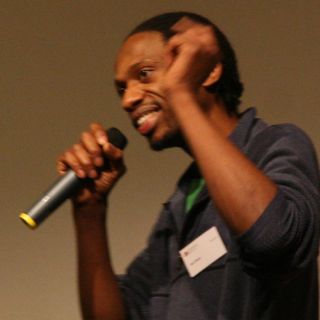
2. Hear the Mercury Theatres’s War of the Worlds radio play here.
3. Hear my interview with astrobiologist Lewis Dartnell here (in spite of the background noise, I think this is a great interview):
4. Video of the separate presentation Paul Davies made after the meeting is here at the Royal Society’s website
5. 4th March 2010 Article in the Times re Monolake shadow biosphere
Update 2 Dec 2010: NASA report Mono Lake bacteria incorporating arsenic into their DNA (Alok Jha in The Guardian)


